We sought to follow as much of the historic route as possible – no easy task in many parts – and solicited the help of Gary Fleshmann, a tour guide who has travelled the length of 66 more than 100 times. Thanks to Gary’s experience, hidden gems of the route and a near endless stream of facts about the history of the communities through which the highway travels were always available. Actively participating in our random and often-trivial discussions over the walkie-talkies, Mr Fleshmann made for an entertaining travel companion, and of course never failed to point out the original stretches of Route 66’s 1920s era Portland cement still exposed on several sections.
For many, Route 66 represented the road to a better life particularly for the countless families suffering through the Dust Bowl of the 1930s in the Midwest. By the ’50s, small towns along the Route were thriving thanks to the constant stream of tourists, and an incredible series of kitschy motels, service stations and cafes that linked the miles together.
As the interstates pulled people away from 66 and consequently away from many of those small towns, most of the character-rich landmarks slowly became redundant. Many aspects of the Route 66 story are surprisingly well told in the Pixar film Cars, which modeled many of the buildings in the fictitious “Radiator Springs” after actual buildings along the Route.
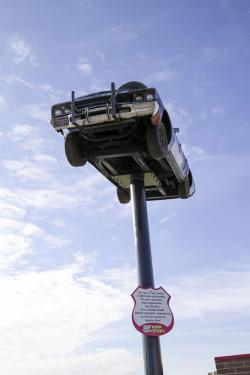 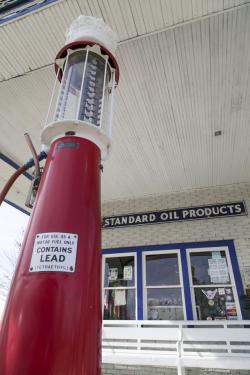 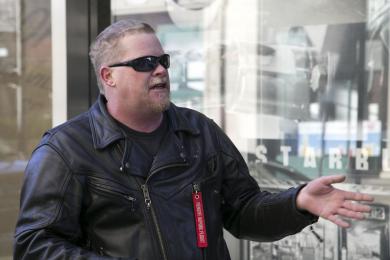 Day 1 – Bluesmobile in Joliet, Illinois; vintage gas pump; Route 66 guide Gary Fleshmann. Click image to enlarge |
Thankfully a number of passionate folks throughout each of the eight states Route 66 traverses have recognized the historic significance of this classic highway and have lovingly restored or preserved some key landmarks. Others – like the numerous classic American motels and service stations in long-forgotten towns – slowly decay into oblivion as a haunting reminder of the cost of progress.
During our first day, the trip took us south from Chicago, through Illinois, passing a handful of icons that still embrace the past. Some, like the restored service centres, celebrate the friendly help motorists could expect along their journey. Other landmarks, like the notorious Stateville Prison, just north of Joliet, IL, or the replica Blues Brothers police car stuck high upon a signpost speak to other, more notorious elements of Americana.
At one point the Chain of Rocks bridge represented an efficient way for Route 66 motorists to get around the traffic of St. Louis, MO, while making the 213 metre span across the mighty Mississippi River crossing from Illinois into Missouri (or Mizzourah as we were told to pronounce it by the locals). But for the last 44 years, it’s been closed to motorized traffic – except with very special permission. Apparently, a motley group of Canadian auto writers in Nissans are special enough to drive across the scenic span.
  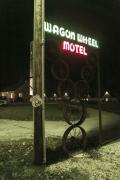 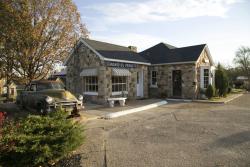 Day 1 – View of Mississippi River; Chain of Rocks Bridge, Illinois-Missouri; Wagon Wheel Motel in Cuba, Missouri. Click image to enlarge |
Our accommodations for the night were in Cuba, Missouri, at the Wagon Wheel Motel. The Wagon Wheel is the oldest still-operating motel along Route 66. Opened in 1935, it has been lovingly restored in recent years to give guests a taste of what it might’ve been like to stay in one of the mom-and-pop-owned motor inns from a bygone era, but now with clean, modern amenities thrown in.















